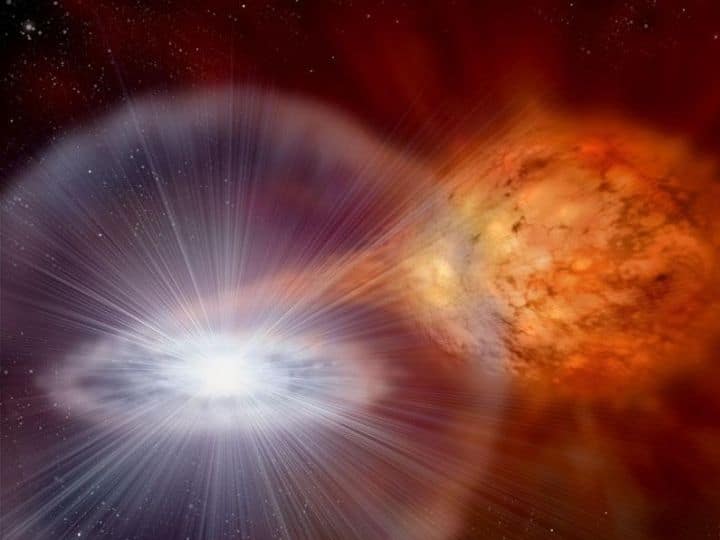MAGIC Telescopes Observe Gigantic Explosion Of White Dwarf In Serpent Bearer Constellation
MAGIC (Major Atmospheric Gamma Imaging Cherenkov Telescopes), a system of two telescopes, has observed the dramatic explosion of a white dwarf in the Serpent Bearer constellation.

New Delhi: A dramatic explosion occurs in the Serpent Bearer constellation, every 15 years or so. This is because the constellation harbours a nova called RS Ophiuchi or RS Oph.
What Is A Nova?
A nova is an explosion from the surface of a white-dwarf star in a binary star system, which occurs when the white dwarf "steals" gas from its nearby companion star, according to StarDate, the public education arm of The University of Texas at Austin's McDonald's Observatory. A white dwarf is the dense core of a once-normal star.
When enough has built up on the surface of the white dwarf, it triggers an explosion.
Therefore, birthplaces of a nova are systems in which two very different stars live in a parasitic relationship.
In this relationship, a white dwarf, which is a small, burned-out and tremendously dense star, orbits a red giant, which is an old star that will soon burn up. A teaspoon of a white dwarf's matter weighs about one tonne.
MAGIC (Major Atmospheric Gamma Imaging Cherenkov Telescopes), a system of two telescopes situated at the Roque de los Muchachos Observatory on La Palma, has observed the gigantic thermonuclear explosion of a white dwarf in the Serpent Bearer constellation. The study, led by researchers at Max Planck Institute for Physics in Germany, was recently published in the journal Nature Astronomy.
What Is MAGIC?
MAGIC is a system of two 17-metre diameter Imaging Atmospheric Cherenkov Telescopes (IACT), which are a device or method to detect very-high-energy gamma ray photons.
The two telescopes are dedicated to the observation of gamma rays from galactic and extragalactic sources in the very high energy range, which is from 30 gigaelectronvolts to over 250 gigaelectronvolts.
The telescopes detect particle showers released by gamma rays using the Cherenkov radiation, which is the light produced by charged particles when they pass through an optically transparent medium at speeds greater than the speed of light in that medium.
What Happens During A Nova?
In the binary star system, a dying giant star sheds its outer hydrogen layer, and the gas flows into the nearby white dwarf.
The flow of matter from the giant star to the white dwarf continues, until the latter overeats or overheats itself. In the newly gained stellar shells, the temperature and pressure become too large. This results in a gigantic thermonuclear explosion. The red giant burns up, but the dwarf star remains intact. The cycle commences again, and the explosion eventually follows.
Such explosions involve high energies, according to the study.
What Did The MAGIC Telescopes Find?
The MAGIC telescopes recorded gamma rays with the value of 250 gigaelectronvolts, which are among the highest energies ever measured in a nova.
The energy of the radiation is hundred billion times that of visible light.
There were initial alerts from other instruments measuring at different wavelengths, following which MAGIC was able to make its observations. In a statement issued by Max Planck Institute for Physics, David Green, one of the authors of the paper, said that the "spectacular eruption" of the RS Ophiuchi shows that the MAGIC telescopes' fast response really pays off. It takes the telescopes no more than 30 seconds to move to a new target, Green said.
Several shock fronts propagated through the stellar wind from the red giant and the interstellar medium surrounding the binary system, following the explosion. According to the study, the shock waves work like a giant power plant in which the particles are accelerated to near the speed of light. The gamma rays emanate from energetic protons, which are the nuclei of hydrogen atoms, the combined measurements suggest.
Green explained that the fact that gamma rays emanate from energetic protons also makes nova outbursts a source of cosmic rays.
He said that nova outbursts, however, tend to play the role of local heroes. This means that they only contribute to the cosmic rays in the close neighbourhood.
Green said that the big players for cosmic rays are supernova remnants because the shock fronts created from stellar explosions are far more violent compared to novar.
According to the researchers, more observations like those reported now will be necessary to fully understand the complicated interplay of violent events with the Interstellar medium in the Milky Way galaxy.
The authors noted in the study that the MAGIC collaboration will therefore continue to look for "restless" objects in the Milky Way galaxy and beyond.






































